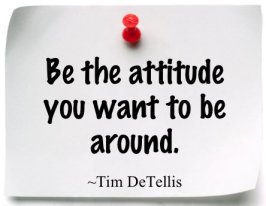“The world has become more competitive; the economy has undeniable vulnerabilities and is in need of reinvention. As in all situations, the determining factor will be our attitude, how we choose to look at this reality.” –50 Cent
I believe the quality of our lives is largely determined by the quality of the questions we are continually asking ourselves. In our ever changing and demanding world how do we first cope with and then embrace change? Let me suggest an answer: attitude. Professor Erwin H. Schell, one of the most respected minds on leadership says, ”obviously, there is something more than facilities and competence that make for accomplishment. I have come to believe that the linkage factor, this catalyst, if you will, can be defined in a single word attitude. When our attitude is right, our abilities reach a maximum of effectiveness and good results inevitably follow.“ I believe attitudes do make a profound difference.

Think about it for a minute. If you are greeted when you enter a store with an authentic and warm smile how do you feel? Compare that to being ignored or glared at when you walk in. How does your greeting effect your emotions? How about your desire to shop? Will you spend more or less time in the store? The salesperson’s greeting reflects their attitude toward their work and your presence. Their attitude affects yours.
As human beings we are keenly attuned to reading attitudes through expressions and voice tones and inflections. We communicate our attitudes, our feelings toward people and things through body and facial expressions. It is said that attitudes are the mirrors of the mind. They reflect thinking. Ask yourself this question; what attitude do people see in you? If you cannot define what your attitude, then how can you change? Awareness will change your perspective. Once you are aware and you are ready to see it, you life and perspective is forever changed.
Have you heard the saying, “Attitude Is Everything”? I believe attitude might really be everything, as it is the lens we look at life through. Success and failure are judged by your attitude. Think about this simple saying, “everyday I am on this earth is a good day!” Imagine if you really believed “everyday I am on this earth is a good day”? By merely waking up you have declared the day, a good day! On the flip side, if you woke up each day with a work to-do list a mile long and lamenting each challenge, how do you see your day? When does you day become a good day? When it is over? Now try a subtle attitude shift. Thank you for having work and clients that create challenges and a mile long list of to-dos. I am not unemployed. Thank you I have a job!
Your attitude shapes your perspective, the way your interpret event, the choices your make, the actions you take and the outcomes you get. You want your life to change? Change your attitude first. Do you want real happiness? Not the kind of happiness that changes moment to moment. Then change your attitude. Here is my secret to true happiness, “even if you have a great attitude already, it could always be better.” Ready to change your attitude?
Make a Choice: Decide what attitude you want to have and choose to adopt that attitude. The real control you have in this life is to “choose your attitude”. Obstacles in life create opportunities, as long as, you shift your attitude to embrace the challenge.
Break Old Patterns: If you catch yourself with a bad attitude, do something radical to change your physiology. Pump yourself up. Clap your hands and shake off the old attitude. Look in the mirror to see what you are reflecting. 
Spend Time with Positive People: Attitudes are contagious. What attitude do you want to catch? If you spend time with people who are on fire for life, then you are likely to be on fire for life.
Ask Better Questions: The ongoing chatter or noise in our heads is a series of questions. The majority of the time it does not even register that this process is going on. Most of the time this is not a very conscious process. Learn to ask a better question. Try this; do you believe life happens to you, or for you? If life happens to you, then your circumstances of the moment determine your happiness. If life happens for you, then even in the most tragic situations there is something to learn or a way to grow. If you are continually learning and growing you are generally pretty happy.
Quit Using Excuses: We tend to stubbornly hold on to our attitudes even when they do not get us the life we want. They are habits and learn to justify them. We have excuses for our excuses. Do you want to hold onto your excuses, or do your want results?
Reminders: Write the attitude you want on a post-it note and put it somewhere so that you’ll see it regularly like on the bathroom mirror or car visor. Set an alarm that goes off at certain times of the day to remind you to grab hold of your new attitude.
Believe: You have to believe! You have to believe that a new attitude is possible and the choice is solely yours!
Time to make a choice! You decide. If attitude is everything, what is your attitude? Remember, the way to true happiness is this, “even if you have a great attitude already, it could always be better.” Ready to change your attitude and have a happier new year? It your choice!
 are like themselves.
are like themselves.










